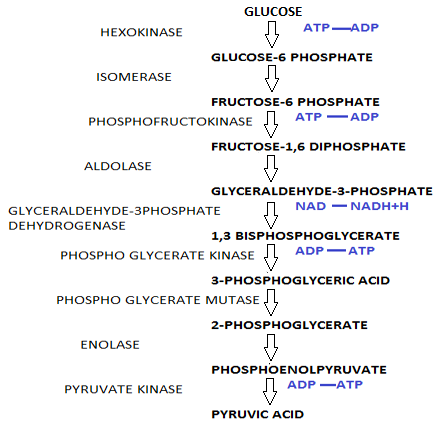
The fermentation of glucose by yeast normally yields
A.Lactic acid,
B.Alcohol,
C.Alcohol,
D.
Answer
402.9k+ views
Hint: Glucose is a type of carbohydrate, it is made up of carbon, hydrogen and oxygen atoms.
Fermentation is defined as the incomplete oxidation of glucose carried out in the absence of oxygen known as anaerobic condition.
Complete answer:
Fermentation of glucose is a type of metabolic reaction which involves many prokaryotic organisms and unicellular eukaryotes like yeast.
Anaerobic conditions are required for the fermentation process to complete because presence of oxygen causes complete oxidation of glucose and yields different products like pyruvate and energy.
Glucose molecules undergo a 9 step reaction to form pyruvate as in the case of glycolysis to and

After glycolysis each molecule of glucose produced two molecules of pyruvate,
After the formation of pyruvate, fermentation enzymes act on it to yield different products in the absence of oxygen.
Pyruvate molecule undergoes decarboxylation process in the presence of pyruvate decarboxylase to yield two molecules of acetaldehyde, two molecules of carbon dioxide and
Where
Acetaldehyde form in the step further undergoes chemical reaction in the presence of enzyme acetaldehyde dehydrogenase to finally form two molecules of ethanol by utilizing the energy formed in earlier step.
Where
Hence, after completion of fermentation process one glucose molecule finally forms Alcohol,
During fermentation a very small amount of energy
Note:
Glucose is commonly known as sugar because of its sweet taste. Glucose comes under the category of monosaccharide because it can not be further hydrolyzed to yield a smaller unit.
Yeast present in the reaction during fermentation undergoes self-death when concentration of alcohol reaches
Fermentation is defined as the incomplete oxidation of glucose carried out in the absence of oxygen known as anaerobic condition.
Complete answer:
Fermentation of glucose is a type of metabolic reaction which involves many prokaryotic organisms and unicellular eukaryotes like yeast.
Anaerobic conditions are required for the fermentation process to complete because presence of oxygen causes complete oxidation of glucose and yields different products like pyruvate and energy.
Glucose molecules undergo a 9 step reaction to form pyruvate as in the case of glycolysis to and

After glycolysis each molecule of glucose produced two molecules of pyruvate,
After the formation of pyruvate, fermentation enzymes act on it to yield different products in the absence of oxygen.
Pyruvate molecule undergoes decarboxylation process in the presence of pyruvate decarboxylase to yield two molecules of acetaldehyde, two molecules of carbon dioxide and
Where
Acetaldehyde form in the step further undergoes chemical reaction in the presence of enzyme acetaldehyde dehydrogenase to finally form two molecules of ethanol by utilizing the energy formed in earlier step.
Where
Hence, after completion of fermentation process one glucose molecule finally forms Alcohol,
During fermentation a very small amount of energy
Note:
Glucose is commonly known as sugar because of its sweet taste. Glucose comes under the category of monosaccharide because it can not be further hydrolyzed to yield a smaller unit.
Yeast present in the reaction during fermentation undergoes self-death when concentration of alcohol reaches
Latest Vedantu courses for you
Grade 11 Science PCM | CBSE | SCHOOL | English
CBSE (2025-26)
School Full course for CBSE students
₹41,848 per year
Recently Updated Pages
Master Class 4 Maths: Engaging Questions & Answers for Success

Master Class 4 English: Engaging Questions & Answers for Success

Master Class 4 Science: Engaging Questions & Answers for Success

Class 4 Question and Answer - Your Ultimate Solutions Guide

Master Class 11 Economics: Engaging Questions & Answers for Success

Master Class 11 Business Studies: Engaging Questions & Answers for Success

Trending doubts
Give 10 examples of unisexual and bisexual flowers

Draw a labelled sketch of the human eye class 12 physics CBSE

a Tabulate the differences in the characteristics of class 12 chemistry CBSE

Differentiate between homogeneous and heterogeneous class 12 chemistry CBSE

Why is the cell called the structural and functional class 12 biology CBSE

Differentiate between insitu conservation and exsitu class 12 biology CBSE




